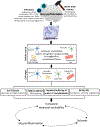Viral Triggers and Inflammatory Mechanisms in Pediatric Epilepsy
- PMID: 29978423
- PMCID: PMC7416551
- DOI: 10.1007/s12035-018-1215-5
Viral Triggers and Inflammatory Mechanisms in Pediatric Epilepsy
Abstract
Experimental and clinical findings suggest a crucial role for inflammation in the onset of pediatric seizures; this mechanism is not targeted by conventional antiepileptic drugs and may contribute to refractory epilepsy. Several triggers, including infection with neurotropic viruses such as human herpesvirus 6 (HHV-6), other herpesviruses, and picornaviruses, appear to induce activation of the innate and adaptive immune systems, which results in several neuroinflammatory responses, leading to enhanced neuronal excitability, and ultimately contributing to epileptogenesis. This review discusses the proposed mechanisms by which infection with herpesviruses, and particularly with HHV-6, and ensuing inflammation may lead to seizure generation, and later development of epilepsy. We also examine the evidence that links herpesvirus and picornavirus infections with acute seizures and chronic forms of epilepsy. Understanding the mechanisms by which specific viruses may trigger a cascade of alterations in the CNS ultimately leading to epilepsy appears critical for the development of therapeutic agents that may target the virus or inflammatory mechanisms early and prevent progression of epileptogenesis.
Keywords: HHV-6; Inflammation; Picornaviruses; Seizures; Theiler’s murine encephalomyelitis virus.
Conflict of interest statement
Figures
References
-
- Ekstrand JJ, Herbener A, Rawlings J, Turney B, Ampofo K, Korgenski EK, Bonkowsky JL (2010) Heightened neurologic complications in children with pandemic H1N1 influenza. Ann Neurol 68:762–766 - PubMed
-
- Murthy JMK (2010) Neurological complications of dengue infection. Neurol India 58:581–584 - PubMed
-
- Solomon T, Vaughn DW (2002) Pathogenesis and clinical features of Japanese encephalitis and West Nile virus infections. Curr Top Microbiol Immunol 267:171–194 - PubMed
-
- Owatanapanich S, Wutthanarungsan R, Jaksupa W, Thisyakorn U (2016) Risk factors for severe enteroviral infections in children. J Med Assoc Thail 99:322–330 - PubMed
-
- Britton PN, Dale RC, Nissen MD, Crawford N, Elliott E, Macartney K, Khandaker G, Booy R et al. (2016) Parechovirus encephalitis and neurodevelopmental outcomes. Pediatrics 137: e20152848. - PubMed
Publication types
MeSH terms
Grants and funding
LinkOut - more resources
Full Text Sources
Other Literature Sources
Medical


